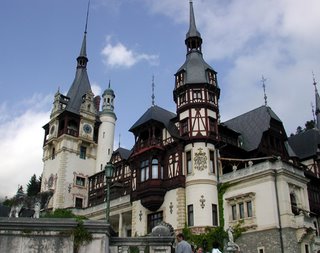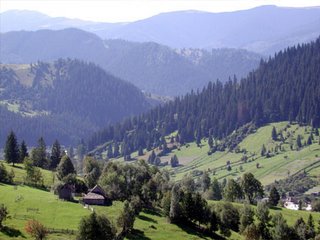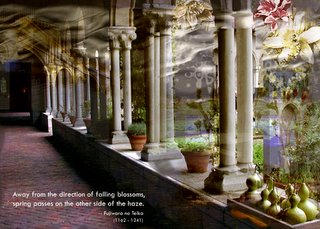
Wednesday, December 13, 2006
Friday, October 06, 2006
Monday, October 02, 2006
Check out BookMooch.com for free book swapping!
In brief:
- you create an inventory of books you want to give away (and get 1/10 of a point for each book added to your inventory)
- browse other peoples' inventories, looking for books or create a wishlist - you'll be notified of matches on books from your wishlist
- if someone requests ('mooches') a book, you get 1 point for sending it
- if you mooch a book, 1 point is subtracted from your total
Those are the basics, but there's quite a bit more: you can donate points to charity, for example. You'll find FAQs and Reader Forums on the site, plus full directions.
It's free to join. BookMooch is the brainchild of a Berkeley fellow who felt that books shouldn't just sit around - they should be shared. I've cleared up quite a bit of bookshelf space -- I had no room for anything current. Now I've got lots of points to use on books I want!
Link is also listed on the blog's sidebar. Enjoy!
Sunday, September 24, 2006
Large Pastel Painting in Progress

This is a pastel painting in progresa of my nephew, Dean, in my family's swimming pool. It's roughly 2/3 completed. I purposely chose a large scale and close cropping to make Dean seem large. I'm also making the sparkling water also look somewhat celestial - like stars. It almost makes Dean seem like a little giant who's playing out in space.
The next photo shows the painting a couple of sessions later. As of today, I'm done a bit more work on it. I've used almost $50 in pthalo blue pastel sticks for the water area alone!
Saturday, September 23, 2006
More photos from Romania
Tales From Romania, Part 3
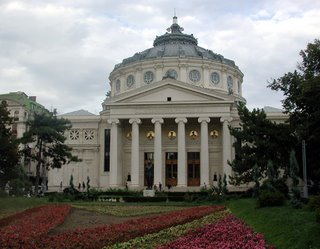


Tuesday, September 19, 2006
Tales From Romania, Part 2
Romania under Communism was like an encounter with a skunk: it's taking a long time to get rid of the stink. In some neighborhoods huge ugly blocks of apartment buildings stand where houses and mansions once stood. People were forced to move into them -- and not allowed to take their beloved pets with them. Today, stray dogs wander the streets as a result. Some buildings are scarred with bullet holes. Other buildings were designed as military enclaves.
Our guide, Tiberiu, told us stories about life under the regime of Nickolai Ceaucescue. While his people starved, he kept builders and workers busy around the clock building a huge palace -- the 2nd largest building in the world. No expense was spared -- the best materials that Romania could provide went into this senseless shrine.
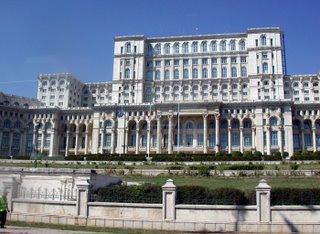
There was only 1 and 1/2 hours of television each day. One hour of fabricated positive news about the government, and 1/2 hour of soldiers, workers, and women dressed up in folk costume pretending to sing, while songs praising Ceaucescue were dubbed over. People stood in long queues for hours, or maybe a whole day, just to buy a loaf of bread.
No contact with outsiders was allowed -- it could mean a 10 year prison sentence (a common punishment, meted out without a trial). You were expected to inform on your neighbors, co-workers, or even family & friends if they engaged in any suspicious or unapproved activities -- of which there were many.
Ceaucescue wanted to develop heavy industry, while Romania historically has been agricultural with some light industry. To create a large workforce, he banned all contraceptives and made abortions illegal. Large families were mandatory and enforced by heavy fines otherwise. The result: children orphaned by poor parents, living in the subway, and sniffing glue. (Take note: anti-abortionists). Women resorted to back alley abortions, and when botched, were forced to bleed to death in pain because doctors would face a severe prison sentence for treating them.
Despite all that suffering and strife, the Romanian people have demonstrated their perseverence and resilience. I was impressed by their will to survive.
Is there a lesson to be learned from their recent history? What happens when a government abandons its people for greed, and egotistical self-righteousness? Romanians can answer those questions for us with stories of their recent past,
Below: a building once notorious for police interrogations, now with a new look
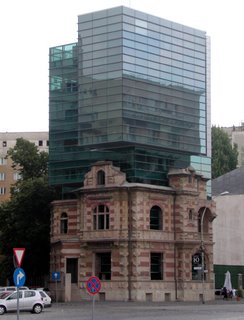
Wednesday, September 13, 2006
My Trip Around Romania

I just returned from a 12-day tour of Romania with 12 other gay American men. I shouldn't tell you this because I should keep the secret.
The secret is: Romania is Europe's best-kept secret.
Over the next few posts I hope to tell you why. For now, let's just say that Romania is a surprisingly stunning and unspoiled country. Squash those images you have of guards and dogs and barbed wire. Banish all images of spooky, craggy castle ruins haunted by Dracula and his minions. The scariest part of my trip was facing the return flight home.
A trip to Romania can teach you a lot about life. As you pass through the countryside, you see small cottages that have wonderful handcarved wooden arched gates that are a distintive welcoming entryway. Big deal, right? Well, those gates speak of the love of the home, and hospitality to visitors. They aren't mass-produced in vinyl and purchased from the same Home Depot found in every town. There are no Home Depots. The gates were individually made by hand, and reflect the owner and his/her favorite images. There's a big difference in the way life happens in Romania: it's genuine, savors time, and yet is about humble, simple beauty.
Almost all of the houses had well-tended gardens with ripe red tomatoes, cucumbers, a patch of corn, huge colorful dahias, roses, and herbs. I often saw a horse in the yard, and maybe a cow or some sheep, a couple of pigs, and some chickens.
Yes, I saw television antennas and an occasional satellite dish, but more frequently I saw folks sitting on benches in front of their houses, visiting with neighbors and watching the world pass by. They weren't fixated by computers, cell phones, or televisions.
I thought technology was supposed to make our lives simple. I think we've been sold an image of the future that isn't less complicated, easier, or better. It's just faster - so fast that we often forget what the great things in life are, I have friends who'll walk past amazing flowers without seeing them, and who haven't touched growing vegetation with their hands in a very, very long time.
Romania made me think about the way my Polish grandmother lived. I was impressed by her full involvement with her work and her life. She was a genuine, loving soul. That's what I observed with the Romanians I watched, too. There wasn't the crazy chase we are in, trying to attain instant gratification, only to pass on to the next object of desire.
That was the foremost lesson Romania made me think about. 
More about the trip and more photos in the next post.
Photo: Old section of Bucharest
Saturday, March 04, 2006
Tanka series #3, "Dewdrop Soul"

This is the third of a set of images based on Japanese tanka poems. Tanka are similar to haiku, but have a different syllabic structure. They refer to nature and seasonal changes as a counterpoint to our lives as humans. In my images, as in the poems, ambiguity is important, as it allows viewers (or readers) to fit the imagery to their own circumstances. My goal is to complete a set of 20 tanka images.
This is "Dewdrop Soul". written by Fujiwara no Teika somewhere around the 12th or 13th centuries. You'll find the other two completed images also posted here (scroll down).




